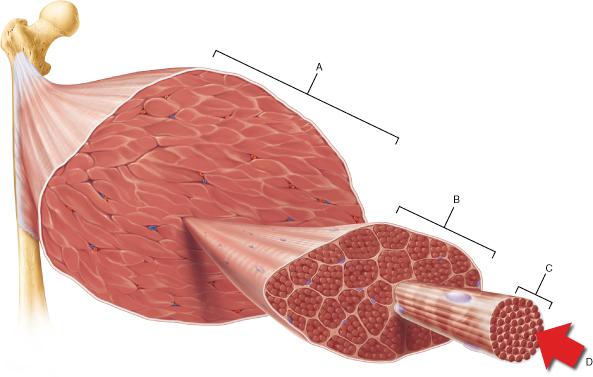
In the figure above, which structure corresponds to a single skeletal muscle cell?
A
B
C
D
C
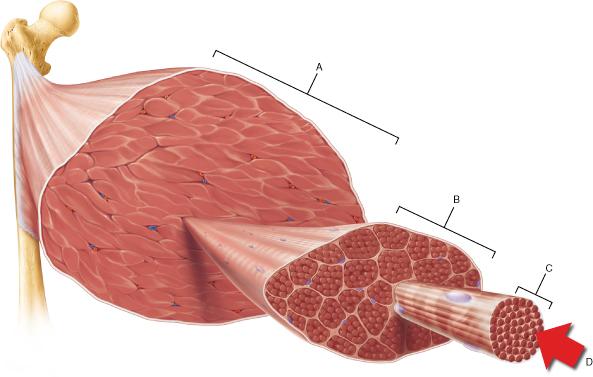
The connective tissue that covers structure A is continuous with which of the following?
sarcolemma
endomysium
ligament
tendon
Tendon
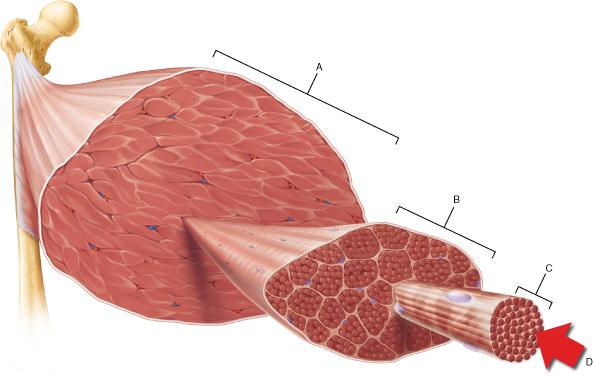
Which structure corresponds to a single fascicle?
A
B
C
D
B
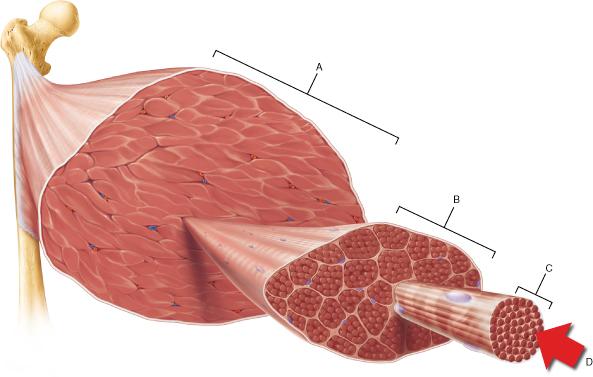
Which of the following is the smallest structural unit in which the distinctive striated bands characteristic of skeletal muscle are observed?
A
B
C
D
D
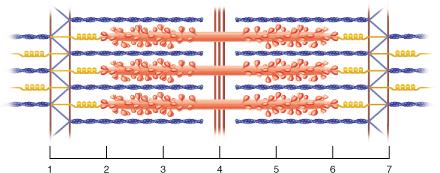
The smallest contractile unit within skeletal muscle would correspond to the distance between which two points in the figure?
1 and 7
3 and 5
1 and 3
2 and 6
1 and 7
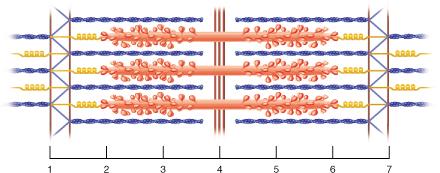
Between which two points would there be substantial amounts of both the proteins actin and myosin?
2 and 3
1 and 2
3 and 5
None of the listed responses is correct.
2 and 3
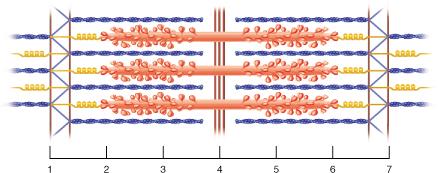
The region between which two points corresponds to the entire A band?
2 and 6
3 and 5
2 and 3
1 and 2
2 and 6
The region between which two points corresponds to the I band?
3 and 5
2 and 5
2 and 3
None of the listed responses is correct.
None of the listed responses is correct.
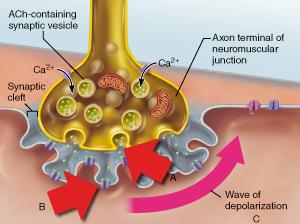
What cellular event is indicated by A?
exocytosis
facilitated diffusion
active transport
endocytosis
exocytosis
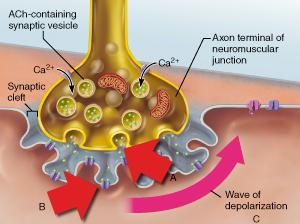
What event directly triggers the release of neurotransmitter shown in A?
diffusion of K+ into the axonal terminus
diffusion of Na+ out of the axonal terminus
diffusion of Na+ into the axonal terminus
diffusion of Ca2+ into the axonal terminus
diffusion of Ca2+ into the axonal terminus
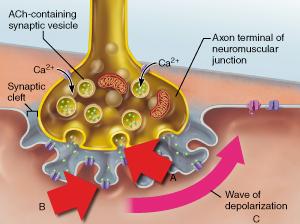
What specific neurotransmitter is released from the axonal terminus as shown in A?
acetylcholine
actin
calcium
myosin
acetylcholine
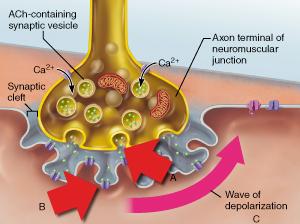
Which statement accurately describes the event indicated by B?
Binding of acetylcholine to a receptor triggers the opening of an ion channel.
Diffusion of Ca2+ into the muscle fiber triggers the diffusion of acetylcholine out of the muscle fiber.
Diffusion of acetylcholine into the muscle fiber triggers the diffusion of Ca2+ out of the muscle fiber.
Diffusion of acetylcholine into the muscle fiber triggers the opening of an ion channel.
Binding of acetylcholine to a receptor triggers the opening of an ion channel.
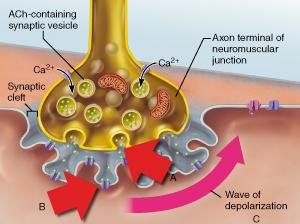
Which event is most significant in initiating the "wave of depolarization" shown in event C?
diffusion of Na+ into the muscle fiber
diffusion of K+ out of the muscle fiber
diffusion of acetylcholine down the length of the muscle fiber
diffusion of acetylcholine into the muscle fiber
diffusion of Na+ into the muscle fiber
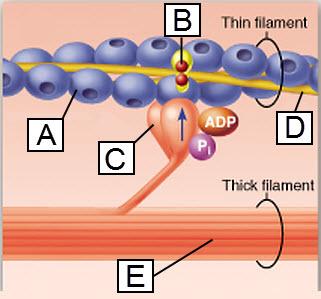
The protein actin is indicated by which letter?
A
B
C
D
A
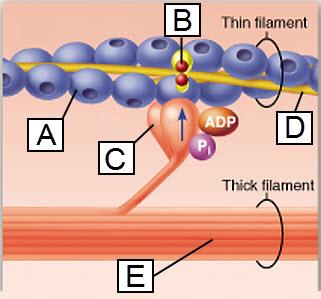
Which protein is indicated by E?
tropomyosin
actin
myosin
troponin
myosin
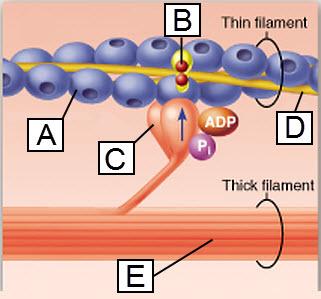
The molecular interaction described as a "cross bridge" involves the binding of which two of the letters below?
A and B
A and C
A and D
B and D
A and C
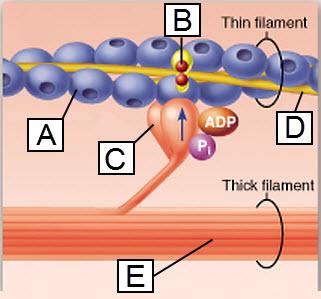
Which lettered protein functions as a motor protein?
A
B
C
D
C
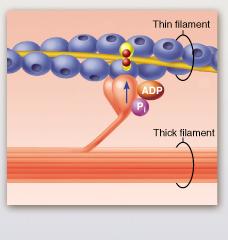
The protein troponin is shown in this figure to be bound to which substance?
sodium ion
myosin
acetycholine
calcium ion
calcium ion
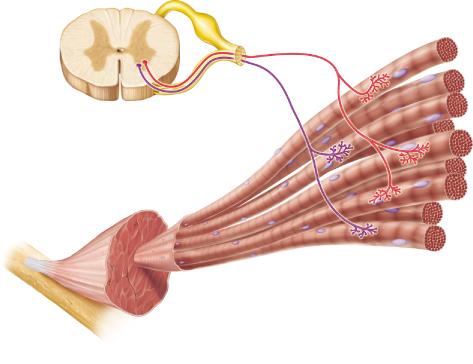
How many motor units are illustrated in the figure?
1
2
5
9
2
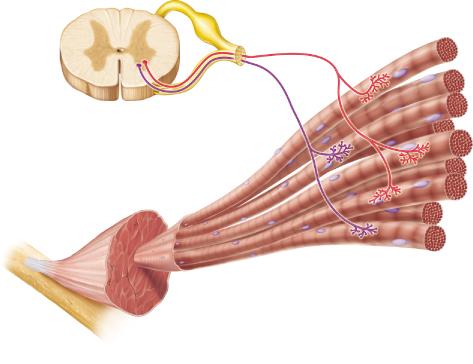
Which of the following describes the neurons shown in this figure?
autonomic motor neurons
somatic motor neurons
sensory neurons
somatic motor neurons
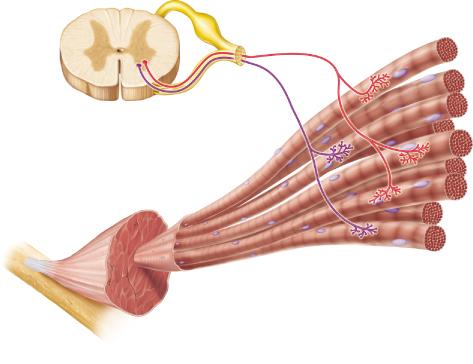
If both of the neurons in the figure were activated, more muscle fibers would contract than if either neuron alone were active. This mechanism for control of the force of muscle contraction is known as ______.
tetanus
recruitment
excitation-contraction coupling
wave summation
recruitment
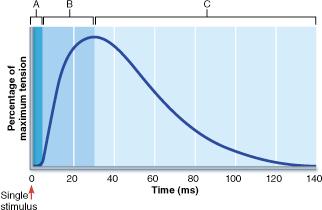
In which phase of the muscle twitch shown in the above figure would the maximum amount of ATP be consumed by myosin head groups?
A
B
C
B
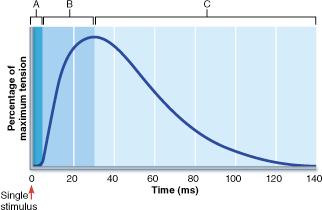
In which phase in the figure would the net movement of Ca2+ into the sarcoplasmic reticulum (SR) be greatest?
A
B
C
C
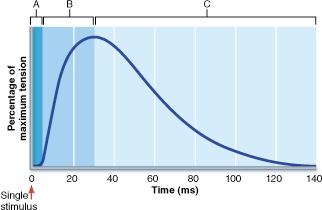
What result would be expected if an additional stimulus, equal in intensity to the first, were to be applied to the muscle at the 60 millisecond (ms) time point?
Tension would increase to the same maximum force measured at the beginning of phase C.
The muscle would quickly return to the fully relaxed state of minimum tension.
The tension exerted by the muscle would continue to decrease, but at a significantly slower rate than observed without the second stimulus.
The muscle would increase in tension to a level greater than that measured at the beginning of phase C.
The muscle would increase in tension to a level greater than that measured at the beginning of phase C.
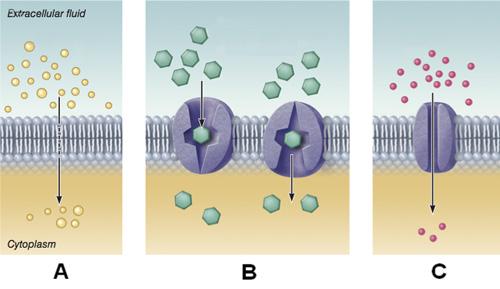
Which mechanism requires energy input by the cell in the form of ATP hydrolysis?
A
B
C
none of the mechanisms require energy input
none of the mechanisms require energy input
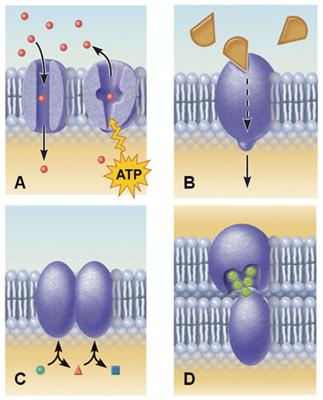
Which of the following events might the solid arrow at the bottom of B represent?
the transport of specific chemical messengers into the cell
the conversion of a chemical messenger molecule into a specific product
the activation of specific cytoplasmic enzymes
the movement of a specific protein from the membrane to the cytoplasm
the activation of specific cytoplasmic enzymes
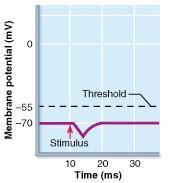
Which of the following is true regarding a response to an excitatory event which might occur soon after the initial stimulus indicated in the graph?
An excitatory event will be more likely to generate an action potential if it occurs during the response to the stimulus observed in the graph.
No action potential can be induced in the neuron by an excitatory event if it occurs during the response observed in the graph.
An excitatory event may result in an action potential, but this will be less likely if the excitatory stimulus occurs during the response to the stimulus observed in the graph.
An excitatory event may result in an action potential, but this will be less likely if the excitatory stimulus occurs during the response to the stimulus observed in the graph.
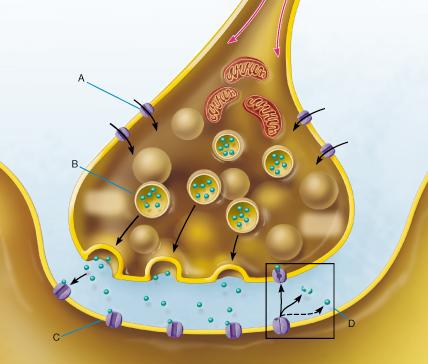
What event is depicted in the structure labeled A?
movement of neurotransmitters into the interior of the axonal terminus through chemically gated channels
movement of Na+ into the interior of the axonal terminus through chemically gated channels
movement of the action potential into the interior of the axonal terminus through voltage-gated channels
movement of Ca2+ into the interior of the axonal terminus through voltage-gated channels
movement of Ca2+ into the interior of the axonal terminus through voltage-gated channels
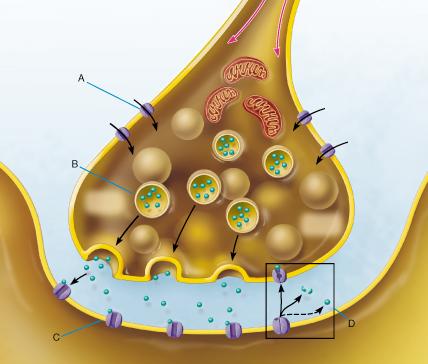
Which of the following most accurately describes the involvement of the structure labeled B in synaptic signaling?
release of Na+ and/or K+ ions into the synaptic cleft by facilitated diffusion
release of neurotransmitter into the synaptic cleft by exocytosis
release of neurotransmitter into the synaptic cleft by active transport
release of Ca2+ into the synaptic cleft by exocytosis
release of neurotransmitter into the synaptic cleft by exocytosis
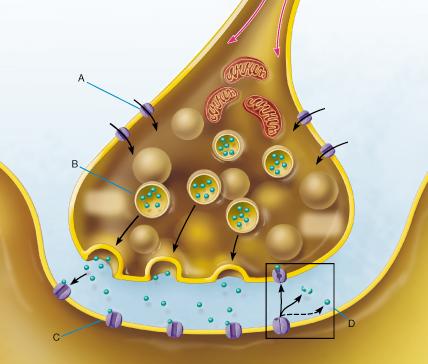
Which of the following statements most accurately describes the effects caused by binding of the ligand shown to the structure labeled C?
The membrane potential of the postsynaptic membrane changes.
The membrane potential of the presynaptic membrane changes.
The ligand is transported into the postsynaptic neuron.
The ligand is transported into the presynaptic neuron.
The membrane potential of the postsynaptic membrane changes.
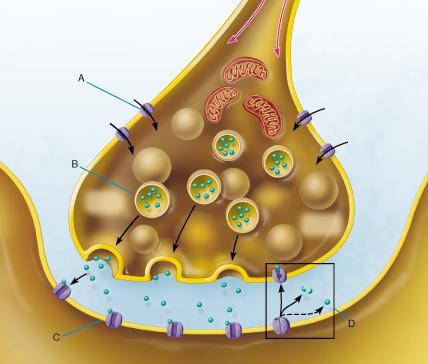
The box labeled D illustrates three mechanisms by which the effects of a neurotransmitter may be terminated. Which of the following mechanisms is NOT included in the figure?
breakdown of the neurotransmitter within the synaptic cleft
reuptake of the neurotransmitter by transport into the postsynaptic cell
reuptake of the neurotransmitter by transport into the presynaptic cell
diffusion of the neurotransmitter out of the synaptic cleft
reuptake of the neurotransmitter by transport into the postsynaptic cell
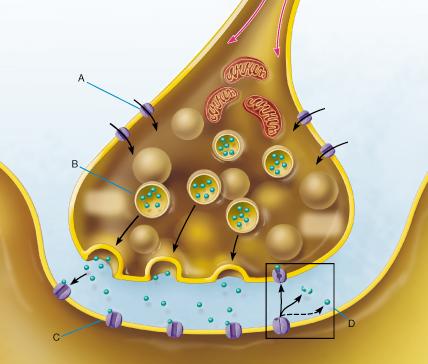
Signals generated at a chemical synapse are said to move only in the direction of the presynaptic cell to the postsynaptic cell. Which of the following statements regarding the mechanisms determining this one way transmission is INCORRECT?
Ions diffusing out of the presynaptic cell can enter the postsynaptic cell, but cannot reenter the presynaptic cell.
The contents of synaptic vesicles are released from presynaptic membranes, not from postsynaptic membranes.
Neurotransmitter receptors are found in the postsynaptic membranes, not in the presynaptic membranes.
All of the listed responses are correct.
Ions diffusing out of the presynaptic cell can enter the postsynaptic cell, but cannot reenter the presynaptic cell.
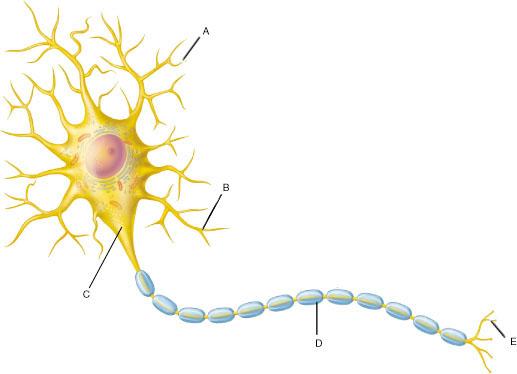
In which area of the neuron is an action potential initially generated?
A
B
C
D
E
C
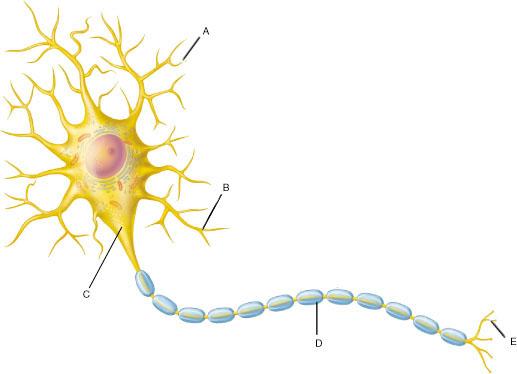
Which of the following membrane regions would have significant numbers of voltage-gated Na+ and K+ ion channels?
A only
A and B
C and D
Voltage-gated ion channels are found in all areas of a typical neuron.
D only
C and D
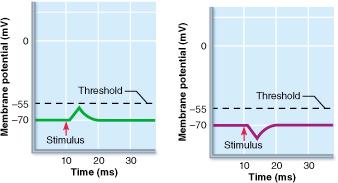
Which of the following statements is true of both membrane potential responses shown in the graphs?
Both responses are examples of IPSPs.
Both responses are examples of EPSPs.
Both responses are examples of graded potentials.
Both responses are examples of action potentials.
Both responses are examples of graded potentials.
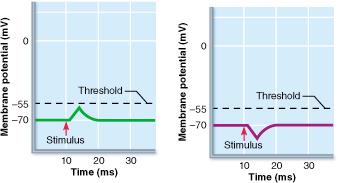
Which result of the stimulus applied is the likely cause of the response observed in the left graph?
opening of gated Ca2+ channels
opening of gated K+ channels
opening of gated Na+ channels
opening of gated Cl- channels
opening of gated Na+ channels
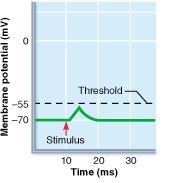
Which of the following is expected to occur first if the membrane potential increase shown in the graph were to reach the threshold value indicated at -55 mV?
opening of voltage gated Na+ channels
opening of chemically gated Na+ channels
opening of voltage-gated K+ channels
opening of chemically gated K+ channels
opening of voltage gated Na+ channels
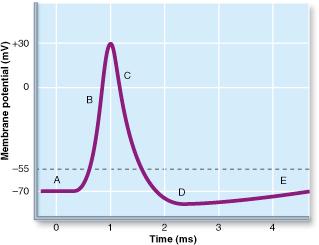
What change in a neuron is being measured in the graph?
the voltage measured across the axon membrane at various points along an axon at a specific instance of time during an action potential
the voltage measured between the neuron cell body and the axonal terminals as an action potential is generated and decays
the speed of an action potential as it moves down the length of an axon
the voltage measured across the axon membrane at a specific point as an action potential travels past
the voltage measured across the axon membrane at a specific point as an action potential travels past
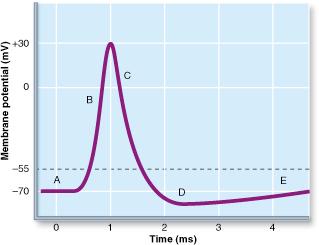
At which point of the illustrated action potential are the most gated Na+ channels open?
A
B
C
D
E
B
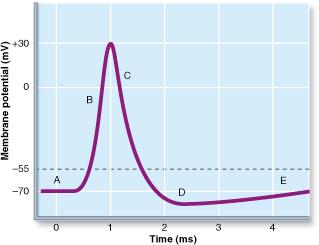
What major ion currents occur at the point along the action potential phase labeled D?
diffusion of Na+ into the axon through gated ion channels
diffusion of K+ into the axon through gated ion channels
diffusion of both Na+ and K+ across the membrane in the direction of their respective electrochemical gradients
diffusion of Na+ out of the axon through gated ion channels
diffusion of K+ out of the axon through gated ion channels
diffusion of K+ out of the axon through gated ion channels
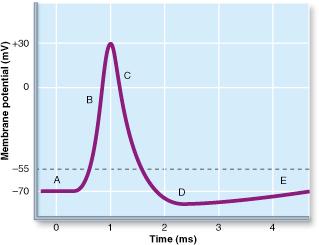
Which of the following mechanisms is most significant in returning the membrane potential to the resting state (from point D to point E)?
the opening of voltage gated Na+ channels
closure of the voltage-gated K+ channels
the opening of voltage gated K+ channels
the closing of leakage channels in the axon membrane
closure of the voltage-gated K+ channels
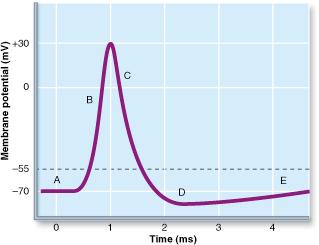
At which of the points along the illustrated action potential can a second action potential be produced, but only with a stimulus significantly greater than that which produced the first?
B
C
D
E
D